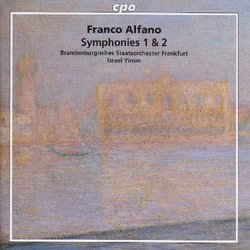| All Artists: Franco Alfano, Israel Yinon, Brandenburgisches Staatsorchester Frankfurt Title: Franco Alfano: Symphonies 1 & 2 Members Wishing: 0 Total Copies: 0 Label: Cpo Records Release Date: 3/22/2005 Genre: Classical Style: Symphonies Number of Discs: 1 SwapaCD Credits: 1 UPC: 761203708024 |
Search - Franco Alfano, Israel Yinon, Brandenburgisches Staatsorchester Frankfurt :: Franco Alfano: Symphonies 1 & 2
 | Franco Alfano, Israel Yinon, Brandenburgisches Staatsorchester Frankfurt Franco Alfano: Symphonies 1 & 2 Genre: Classical |
Larger Image |
CD Details |
CD ReviewsLittle-Known Orchestral Music by Franco Alfano J Scott Morrison | Middlebury VT, USA | 03/22/2005 (3 out of 5 stars) "To the degree that Franco Alfano (1875-1954) is remembered today outside Italy it is primarily for his completion of Puccini's last opera, 'Turandot,' at the request of the Ricordi publishing house after Puccini died before finishing that opera's third act. His completion has been roundly criticized, and indeed at the première performance Toscanini did not perform it out of homage to Puccini. But when he did, at the next performance, play the completion, he played a much cut version. Indeed Alfano's original version was never performed until some time in the 1980s. Be that as it may, Alfano in his own time was a fairly successful operatic composer and he is remembered for three in particular: 'Risurrezione,' based on Tolstoy's 'Resurrection,' 'Sakùntala,' based on a Sanskrit tale, and more recently 'Cyrano de Bergerac,' based on Rostand's famous play. All three are successful works.
Almost nobody knows that Alfano wrote two symphonies. But the cpo label, which has a genius for bringing us unknown or forgotten works, has just released this performance of Alfano's two symphonies. The first, written in 1910, is a rather rambling thing that doesn't quite cohere but which contains some striking music nonetheless. There is a medieval air that hangs over the work, and indeed it is subtitled 'Classica.' This certainly does not refer to the 'classical style' of composition, but rather seems to imply an evocation of ancient music, and it certainly has that. There are some faint Orientalisms not unlike those in Puccini--perhaps that's one reason Alfano was asked to complete Puccini's Chinese opera--with echoes of Respighi (who actually hadn't written all that much when this symphony was written), Rimsky-Korsakoff as well as Impressionistic washes of harmony reminiscent not so much of Debussy as of Scriabin. Melodic construction is odd, harmonic handling is a bit rough-and-ready, and the form is a bit hard to fathom--in all three movements--but there is something here, exciting orchestral color and repeated climaxes which, although they don't make much formal sense, are still pretty effective. The Second Symphony, written in 1931, is written in a sparser, less colorful language, a rather more neo-classical style. There are some oddities--one passage in the first movement, repeated several times, has a strange sudden cutting off of final chords of several similar phrases; the first time through I thought it was a defect in the CD it was so unexpected; later I grew to rather like the effect, although I'm not quite sure what purpose it served other than to call attention to itself. It occurs to me just now as I write this that something similar happens from time to time in Janácek. Harmonies are more successfully managed, are a bit more astringent, and sound rather more 'modern' than anything in the First Symphony. The second movement, Largo, is a pastorale partaking of a summer-like languor. It has some lovely woodwind solos. The finale, 'Solenne--Allegro alla marcia (pomposo),' begins with hieratic trumpet fanfares which usher in a mock-serious march that has some similarities to Prokofiev's march from 'The Love for Three Oranges' which was written at ten years or so earlier. Considering that Alfano knuckled under to the demand of the Italian Fascist arts committee to make his music more accessible to the masses, one wonders if this ironic allegro is his Shostakovian nose-thumbing at the powers-that-were. For all its supposed high spirits, this march has an edgy undertone that suggests as much. These two performances by the Brandenburg State Orchestra of Frankfurt (the less-well-known eastern Frankfurt am Oder, very close to the Polish border) under Israel Yinon scrambles at times, but gives a more-or-less adequate overall impression of these two symphonies, and let's face it, there are not likely to be any other recordings any time soon. So, if you're interested in the orchestral output of this Italian who is so often mentioned in the same breath as Malipiero, Casella, Pizzetti and Respighi, this is your chance to familiarize yourself with some. Scott Morrison" |
